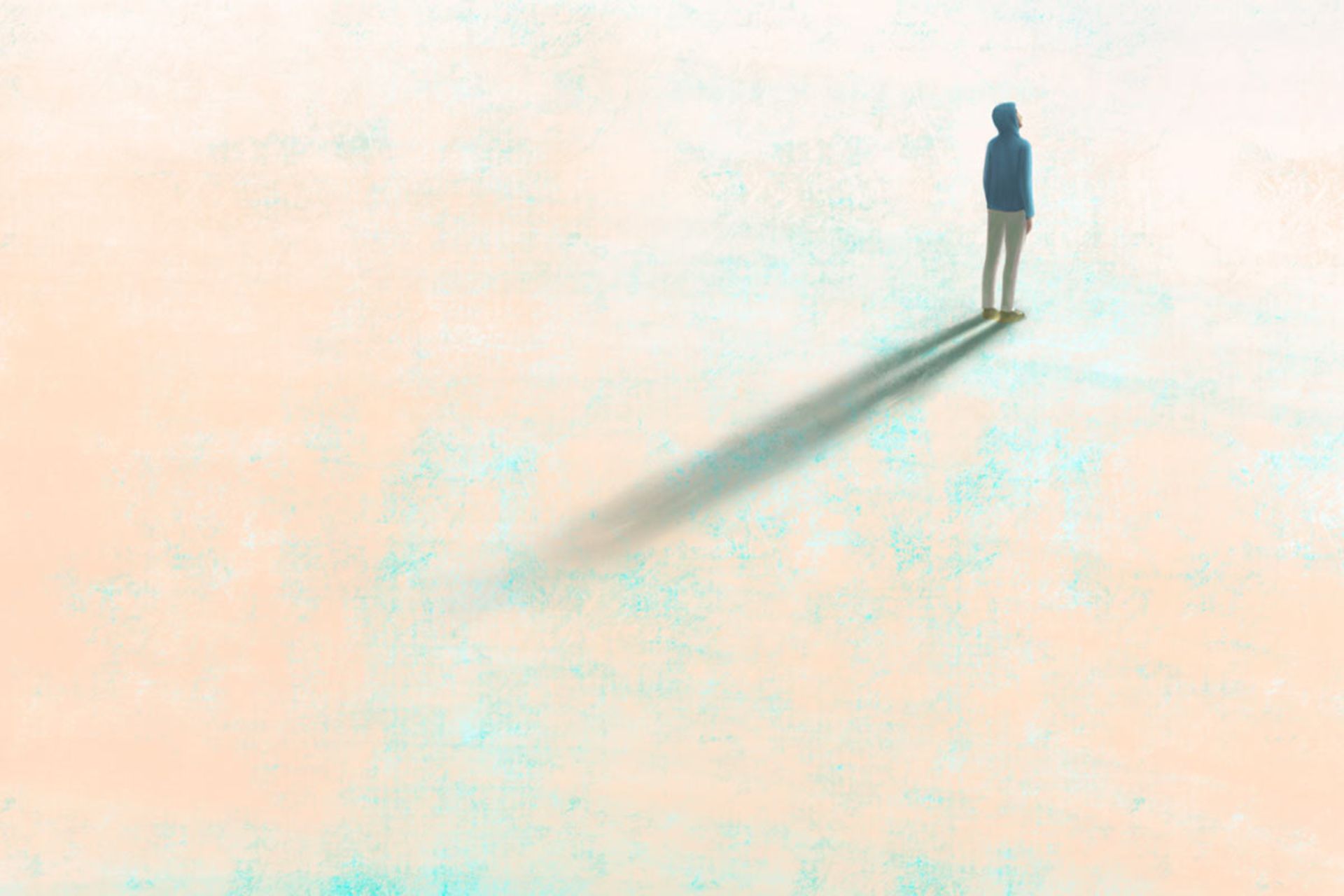
Richard WeisbordIn the early months of 2020, along with the worldwide quarantine of Covid-19, the psychologist and lecturer at Harvard University started a new study. In his opinion, loneliness or its specter is everywhere. Two years ago, Weisbord read a study from insurance provider Cigna that found 46 percent of Americans sometimes or always feel lonely, a number that rose to 52 percent in 2019 when the study was repeated. Weisbord thought, in quarantine, this number has increased a lot.
Weisbord wanted to know what loneliness feels like for lonely people. What are its possible consequences? And what causes it? It is difficult to answer these questions; Because loneliness is a complex or multidimensional feeling; That is, it contains the elements of sadness and anxiety, fear and heartbreak. The experience of loneliness is personal and highly subjective (internal) that depends on a person’s way of thinking. A clerk in a busy grocery store can be intensely lonely, just as a recluse living in a cave can endure solitude in complete happiness.
Loneliness should not be confused with isolation. For convenience, most researchers still use the definition coined by social psychologists almost three decades ago, in the early 1980s. Loneliness is described as “the difference between desired and achieved levels in one’s social relationships” which, unfortunately, is also very subjective.
To understand the current loneliness crisis, Weisbord, who leads a Harvard project on health and well-being, created a 66-question survey and sent it to about 950 people across the United States. With the exception of a few direct statements such as “In the past four weeks, how often have you felt lonely?”, most questions indirectly explore loneliness from different angles; For example, are there people in your life who seek your opinion on things that are important to you?
Loneliness is an epidemic that is felt more in today’s society
Some of the other questions in the questionnaire included: “Do you feel that you connect with people more than they connect with you?” or “Has anyone taken more than a few minutes to ask you how you’re doing in a way that makes you feel like they really care?”
When the results came in, Weisbord was shocked by the extent of the loneliness problem; 36% of respondents experienced chronic loneliness and 37% experienced occasional loneliness in the last month. Among those who felt lonely, 46 percent said they interacted with people more than people interacted with them, and 19 percent felt that no one outside of their family cared about them at all.
In February 2021, as Harvard planned to resume face-to-face classes, the Weissboard team released the results of the survey, highlighting deep social issues in America. These findings attracted a lot of attention and many saw themselves as partners.
A 2021 Gallup poll found that 25 percent of adults often feel lonely, and nearly 40 percent of young adults do so regularly. Although these numbers have improved slightly, 25% of Americans still feel more lonely than before they were born.

Photographer: Andrew Gook
last yearVivek Murthythe US Surgeon General, released a report calling loneliness an epidemic that affects Americans more than diabetes or obesity. The World Health Organization also classified loneliness as a global public health concern. Like depression and anxiety, loneliness has become a hot topic in culture and has spawned numerous articles, self-help books, podcasts, and even startups focused on loneliness.
Japan and Britain have even appointed single ministers tasked with monitoring and ameliorating the depth of the crisis, either through public awareness campaigns or initiatives such as a scheme in the UK where letter carriers were asked to meet elderly residents on routes. Call yourself.
Attempts to address loneliness often show that simple actions such as a phone call, email, or meeting can solve the problem by restoring lost social connections. However, this view misunderstands the complexities of modern life and may distract from deeper problems such as alienation, isolation, mistrust and disconnection. These issues stem from the weakening of institutions and traditions that once bound people together, and addressing them requires more than a return to the past.
Unlike anxiety or depression, loneliness is a relatively modern concern. Alberti bandhistorian, in his book, A Biography of Loneliness, points out that loneliness, as we understand it today, was not widely discussed in the Western world until after the 1800s.
Loneliness is a relatively modern concern
It is not correct to say that no one knew the word loneliness before the 1800s; But loneliness was not always associated with negative feelings. While the word appeared in Shakespeare and Robinson Crusoe, solitude was often seen as a positive experience, especially in the busy past.
Prior to the 19th century, loneliness did not carry the same emotional weight as it does today, Alberti notes. His research shows that there was no mention of “solitude” in English literature until about the 1820s, when the term suddenly became very popular. This change coincided with rapid changes in society, such as war, industrialization, and urbanization, which tore apart traditional societies and led people to seek new ways to express the emotional effects of these changes.
In the 1950s, American scholars began to explore loneliness as a modern subject, paving the way for loneliness studies. David ReismanThe sociologist linked loneliness to social changes in post-war America. In his book The Lonely Population, Reisman explained how prosperity leads Americans to focus on material possessions and social comparisons; A behavior that he called “other-oriented”. This phenomenon is similar to today’s term FOMO (fear of being left behind). When people can’t get what others enjoy, the feeling of loneliness starts.
Some experts consider loneliness a severe medical condition, similar to depression, with debilitating effects. Louise Hawkley and John CacioppoAmerican psychologists used hypnosis in an experiment to induce loneliness in participants. This led to an increase in people’s blood pressure and inflammation, showing that loneliness directly affects health. When the loneliness induction was over, their health indicators improved.
Loneliness is a biological signal designed to motivate us to seek social connection and support
In another study by Hawkley and Cassiopoparticipants were removed from a social activity to demonstrate that loneliness, similar to physical pain, triggers a pain response in the brain. Like hunger, this response is a biological signal designed to motivate us to seek social connections and support.
Loneliness can become a self-reinforcing cycle, where fear and anxiety convince people that they are not worth connecting with, making them feel trapped and increasingly isolated. A study by Daniel Maitlandpsychologist, conducted in 2021, showed that when lonely people are asked to share personal details, they experience a lot of stress, indicating that vulnerability is a big challenge for them. This makes the traditional advice to join social activities ineffective, as such gatherings are outdated and unattractive to many.
Robert Putnam In his book “Bowling Alone”, he noted the decline of American participation in organizations and social groups. Almost 25 years later in 2024, fewer Americans are getting married than in the mid-20th century. The number of people living alone has more than tripled to 29%. But being married doesn’t necessarily prevent loneliness, because a bad marriage can be very isolating, and likewise, living alone doesn’t always mean being alone.
Less attendance at religious ceremonies is also an example of reducing the traditional activities of the society. Weisbord believes religious communities are places where adults engage with children, defend moral values, and engage children with big moral questions. He says he does not suggest becoming more religious; But in those aspects of religion where you feel an obligation to your ancestors and children, there is a structure to deal with grief. We have to figure out how to reproduce those aspects of religion in secular life.
Weisbord and Milena Batanovathe project’s director of research and evaluation, found in a follow-up survey that many respondents attributed their loneliness to a lack of “meaningful connection”; Even when surrounded by others. Emotional closeness rather than physical presence was often the main issue, and some felt devalued or disconnected from those around them.
Working doesn’t bring much relief, as fewer Americans find meaning in their careers, especially as the rise of remote work complicates community building. Older people are more likely to have found meaningful relationships and close friends at work, while younger people struggle with dating due to the shift to telecommuting and virtual communication.
The epidemic of loneliness has left lasting effects on social interactions; So that many people with poor social skills were released from quarantine. Simultaneously with the rise of frictionless forms of digital interaction, such as automated payment systems and food delivery, a phenomenon has emerged that some experts call “cocooning”; It means retreating to the digital world that lacks meaningful communication of people.

iStock
Julian Holt Lanstadprofessor of psychology and neuroscience at Brigham Young University, noted that from 2003 to 2020, Americans spent more time alone and less time with friends and family. The data backs this up, showing that many people struggle with relationship issues and feel like they don’t connect well with people. This suggests that many Americans are not getting the social support they need, either because of loneliness or actual isolation.
Historically, the peak of loneliness has coincided with major social changes. Eric Kleinenbergsociologist, notes that loneliness often became a major concern during times of cultural change, such as the advent of radio in the early 1900s, the rise of the automobile culture, and the social upheavals of the 1960s and 1970s. according to Kleinenbergloneliness is often used to explain the discomfort felt when cultural changes occur too quickly and people cannot adapt.
The epidemic of loneliness today is very deep; Because it is happening on an unprecedented scale, driven by drastic changes in social life, including political dysfunction, mental health crises, and the transformation of communication through the Internet. Many people express longing for the past, when social connections seemed stronger, but this nostalgia may not provide a realistic solution to the current crisis. Instead, efforts such as encouraging face-to-face activities and fostering traditional forms of community may help, perhaps not completely solve the problem.
Perhaps the solution to loneliness is new ways of interacting
History shows that social change often leads to new forms of society rather than a return to old forms. For example, during the Industrial Revolution, people adapted to building new urban societies instead of retreating to rural life. Similarly, the way out of today’s loneliness may involve embracing new forms of communication, such as those enabled by smartphones and the Internet, that can create meaningful relationships despite physical distance.
The evolution of social interactions today, with online platforms allowing people to communicate in ways that were previously impossible. Such an opportunity may be part of a broader adaptation process. In other words, the current period of loneliness can be a transitional phase in which society adapts to new realities and finds new ways to connect and support each other.
Finally, the crisis of loneliness may represent an evolutionary step toward new forms of togetherness; Where, despite physical separation, people find ways to reconnect and create meaningful relationships in the modern world.









